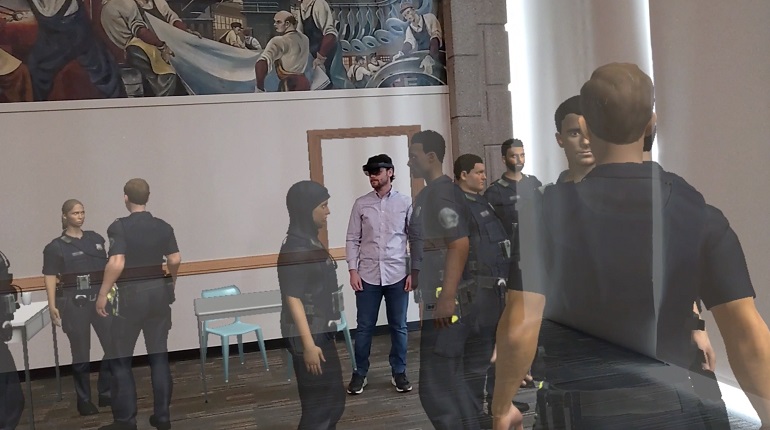
A team of researchers from Wayne State University was awarded a $1.3 million, three-year grant from the U.S. Department of Defense to study “Advanced wireless augmented reality-enhanced exposure therapy for post-traumatic stress disorder.”
The project will be led by Associate Professor of Psychiatry and Behavioral Neurosciences Arash Javanbakht, M.D., who directs the Stress, Trauma and Anxiety Research Clinic, or STARC, and invented the technology.

Dr. Javanbakht, a psychiatrist whose work focuses on anxiety, trauma and PTSD, often helps civilians, refugees and first responders with mental health disorders.
Augmented reality, or AR, is an interactive human-computer technology that enables mixing virtually created objects with reality. Instead of creating a completely synthetic environment, as with virtual reality, AR adds objects to the real world.
The purpose is to provide therapists with a variety of feared objects and situations at their command to use for exposure therapy, and help contextualize safety learning in as many real-life environments as possible. The patient’s AR headset wirelessly connects to the therapist’s computer, where the therapist can see a three-dimensional map of the patient’s environment.
“This grant supports us to fine tune this technology for specific needs of veterans with PTSD,” Dr. Javanbakht said. “This will take place by using feedback from national expert therapists and veterans with previous PTSD who have received treatment. Then, the fine-tuned technology will be used for treatment of veterans with PTSD in a clinical trial, combined with traditional therapies.”
One especially disabling symptom of PTSD is avoidance of anything that can resemble trauma or, in case of traumas caused by humans, most public situations. As a result, many patients with PTSD avoid going to a restaurant, movie, family events, work or even a grocery store, Dr. Javanbahkt said.

“Conventional treatments are more focused on PTSD symptoms and less on this disability, as it is not possible to replicate these real-life conditions in the clinical setting,” he said. “We use AR to position realistic digital human characters within a patient’s real-world environment to practice being comfortable around them. You wear AR goggles, and you find yourself in an immersive party, restaurant, sporting event, police or fire station – for police and firefighters – where you can walk around and interact with nearly 100 characters of diverse age, sex, race, body type and behavior.”
Some of the AR characters in this patented technology are motivated by artificial intelligence, which can facilitate mimicking a real-world conversation, such as a police officer having to de-escalate a situation with an angry citizen they have pulled over for speeding. (Watch video)
Dr. Javanbakht has been using AR technology in psychotherapy since 2016, first testing it in a research setting for treatment of phobias. Learn more about the STARC Lab’s research, including the use of AR, at https://www.starclab.org/projects
“This project is an excellent example of how faculty at Wayne State University are leveraging innovative AR technology to address a debilitating mental-health challenge like PTSD,” said Ezemenari M. Obasi, Ph.D., vice president for research at Wayne State. “This project led by Dr. Javanbakht will play a vital role in advancing “real-life” exposure therapy for PTSD.”
The project complements two aspects of WSU’s Prosperity Agenda, including empowering health for urban neighborhoods by directly addresses disability and real world social and occupational functioning in veterans, first responders, refugees and urban citizens. The project also fuels innovation for WSU’s competitiveness, showcasing patented and pioneering technology.
The grant number for this Department of Defense project is HT9425-24-1-0358.